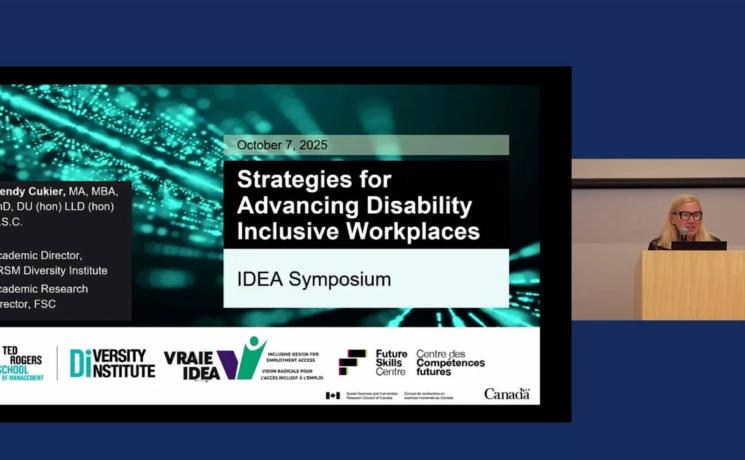Ignore the noise: majority of Canadians still support EDI

In Canada, more than one in four people (27%) now identify as having a disability, reflecting a significant demographic shift and a growing recognition of disability in its many forms. While stigma has decreased, barriers remain: nearly one-third of youth with more severe disabilities are neither in school nor employed, and research shows that university graduates with severe disabilities face worse employment outcomes than high school dropouts. These trends highlight the urgent need to rethink how workplaces, schools and policymakers approach accessibility and inclusion.
This October, during Disability Employment Awareness Month (DEAM), Wendy Cukier, Founder and Academic Director of Toronto Metropolitan University’s Diversity Institute (DI) and proud member of the Inclusive Design for Employment Access (IDEA) Advisory Committee, shared strategies to advance disability-inclusive workplaces. Cukier emphasized that equity, diversity, inclusion and accessibility (EDIA) are not just moral imperatives; they are essential for innovation, productivity and competitiveness. Presenting at the Disability and Work in Canada 2025 Policy Roundtable and the IDEA Symposium, she underscored that inclusive design and equitable employment practices are key to unlocking Canada’s full economic potential.
Cukier noted that the changing economic landscape is compounding challenges for workers. The rise of artificial intelligence is eroding many entry-level roles, trade disruptions are reshaping industries, and cuts to immigration have left some sectors struggling to fill skills gaps. Against this background, research from DI shows that persons with disabilities remain underemployed, underpaid and face persistent barriers to career advancement. Emphasizing the urgent need to consider accessibility and inclusion now, Cukier cited late Lieutenant Governor David Onley, who, speaking a decade ago noted that about 17% of Ontarians identify as having a disability, but 55% of the population has an immediate family member affected by a disability. Strategically it's important to understand that organizations that misstep, risk alienating not just persons with disabilities but their families.
A recent study by DI and the Environics Institute, which included over 40,000 respondents over 8 waves of surveys, found that 33% of Canadians whose disability often or always limits their activity report experiencing workplace discrimination, with rates highest among younger workers (36%) and those with cognitive differences (58%). Furthermore, disability-based reports of discrimination were most frequent in the non-profit sector (44%), followed by the public sector (39%) and lowest in the private sector (30%). And while EDI backlash seen south of the border is having spillover effects, new data from a report by the Diversity Institute with Environics and supported by the Future Skills Centre , Equity, Diversity and Inclusion Backlash? What Canadian Workers Really Think, highlights the Canadian perspective: a majority (54%) of Canadians say efforts to increase EDI at work are a good thing, while only 16% view them negatively, and nearly half report their employer’s approach to EDI has positively affected their opportunities.
Cukier highlighted that with most private-sector employment concentrated in small and medium-sized enterprises (SMEs), it is essential to engage these businesses in building more inclusive workplaces. Through the Skills Bridge Project, a partnership between DI, the Future Skills Centre, Magnet and the Ontario Chamber of Commerce, employers receive free online training—including modules focused on EDIA—to strengthen inclusive hiring and retention practices. She also emphasized entrepreneurship as a viable path for persons with disabilities, because it often offers more flexibility than traditional employment and because cognitive differences can be an advantage in identifying opportunities and pursuing entrepreneurial goals, adding that Forbes has called “ADHD the entrepreneur’s superpower.”
The path forward
Cukier emphasized that progress begins with leadership. Promoting persons living with disabilities into governance and senior roles not only ensures diverse perspectives in decision-making but also embeds accessibility into organizational culture. Representation at the top sets the tone across the workplace, signalling that inclusion is a strategic priority and encouraging employees to engage and support accessibility initiatives.
She also pointed to the need to redesign human resources processes from an accessibility perspective, including recruitment, training, retention, promotion and departure practices. A tool to support this transformation within organizations is DI’s Diversity Assessment Tool, which helps organizations self-assess across six pillars: leadership and governance, human resources, culture, performance indicators, value chain and community engagement. Following the tool’s assessment, it compares the answers to leading practices and helps develop a customized strategy to improve an organization's EDI strategy. The DI has also worked with a range of organizations, to augment the DAT with a disability assessment tool to offer a deep dive into creating inclusive workplaces. Creating systems that allow employees to request accommodations without fear of discrimination is key to equitable opportunity. Ultimately, embedding inclusion and accessibility as core organizational values ensures that “tone from the top” translates into meaningful, sustained action and growth.
